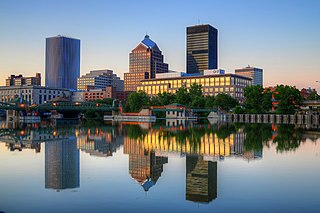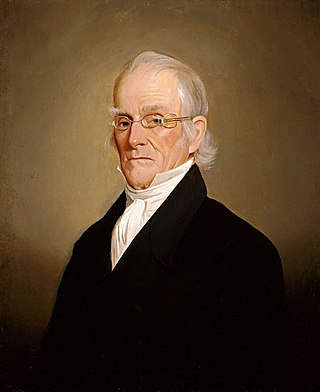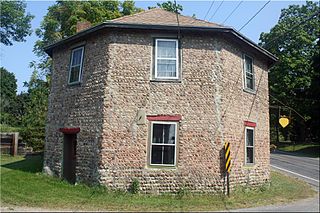Related Research Articles

Rochester is a city in the U.S. state of New York and the county seat of Monroe County. It is the fourth-most populous city and 10th most-populated municipality in New York, with a population of 211,328 at the 2020 census. The city forms the core of the larger Rochester metropolitan area in Western New York, with a population of just over 1 million residents. Throughout its history, Rochester has acquired several nicknames based on local industries; it has been known as "the Flour City" and "the Flower City" for its dual role in flour production and floriculture, and as the "Imaging Capital of the World" for its association with film, optics, and photography.

Nathaniel Rochester was an American Revolutionary War soldier and land speculator, most noted for founding the settlement which would become Rochester, New York.

The Genesee River is a tributary of Lake Ontario flowing northward through the Twin Tiers of Pennsylvania and New York in the United States. The river contains several waterfalls in New York at Letchworth State Park and Rochester.

The Phelps and Gorham Purchase was the sale, in 1788, of a portion of a large tract of land in western New York State owned by the Seneca nation of the Iroquois Confederacy to a syndicate of land developers led by Oliver Phelps and Nathaniel Gorham. The larger tract of land is generally known as the "Genesee tract" and roughly encompasses all that portion of New York State west of Seneca Lake, consisting of about 6,000,000 acres (24,000 km2).
The Auburn and Syracuse Railroad was incorporated on May 1, 1834, to provide easy access between Auburn, New York, and the Erie Canal. Construction was begun in 1835, but was delayed during the Panic of 1837. Although the economic downturn lingered until 1843, the railroad was completed by January 1838.

New York State Railways was a subsidiary of the New York Central Railroad that controlled several large city streetcar and electric interurban systems in upstate New York. It included the city transit lines in Rochester, Syracuse, Utica, Oneida and Rome, plus various interurban lines connecting those cities. New York State Railways also held a 50% interest in the Schenectady Railway Company, but it remained a separate independent operation. The New York Central took control of the Rochester Railway Company, the Rochester and Eastern Rapid Railway and the Rochester and Sodus Bay Railway in 1905, and the Mohawk Valley Company was formed by the railroad to manage these new acquisitions. New York State Railways was formed in 1909 when the properties controlled by the Mohawk Valley Company were merged. In 1912 it added the Rochester and Suburban Railway, the Syracuse Rapid Transit Railway, the Oneida Railway, and the Utica and Mohawk Valley Railway. The New York Central Railroad was interested in acquiring these lines in an effort to control the competition and to gain control of the lucrative electric utility companies that were behind many of these streetcar and interurban railways. Ridership across the system dropped through the 1920s as operating costs continued to rise, coupled with competition from better highways and private automobile use. New York Central sold New York State Railways in 1928 to a consortium led by investor E. L. Phillips, who was looking to gain control of the upstate utilities. Phillips sold his stake to Associated Gas & Electric in 1929, and the new owners allowed the railway bonds to default. New York State Railways entered receivership on December 30, 1929. The company emerged from receivership in 1934, and local operations were sold off to new private operators between 1938 and 1948.

Genesee Brewing Company is an American brewery located along the Genesee River in Rochester, New York. From 2000 to 2009, the company was known as the High Falls Brewing Company. In 2009, High Falls was acquired by the capital investment firm KPS Capital. Together with newly acquired Labatt USA, KPS merged the two companies as North American Breweries. Along with this change, High Falls Brewery changed its name back to the original "Genesee Brewing Company" operating under the North American Breweries name. In October 2012, North American Breweries was purchased by FIFCO.

New York's 24th congressional district is located in Upstate New York in the Finger Lakes region, stretching alongside Lake Ontario from near Buffalo in the west to Watertown in the east. The district does not include Rochester, which is in the 25th district. Since 2023, it has been represented by Claudia Tenney. In the 2022 election it voted more strongly Republican than any other district in the state. Prior to the redistricting which took effect in 2023, the district included the city of Syracuse.

New York State Route 48 (NY 48) is a 28.20-mile (45.38 km) north–south state highway in Central New York in the United States. The southern terminus of the route is located at Interstate 690 (I-690) exit 3 near the interchange between I-690 and the New York State Thruway (I-90) in Van Buren, northwest of Syracuse. The northern terminus is located at an intersection with NY 104 in Oswego. In between, NY 48 passes through the riverside communities of Baldwinsville and Fulton and runs alongside both the Seneca River and Oswego River. For most of its route, NY 48 serves as an alternate route of NY 481. The routes share similar alignments along the Oswego River from the Syracuse area to Oswego, with NY 481 following the eastern riverbank between the two locations.

The Rochester-Genesee Regional Transportation Authority (RGRTA) is a New York State public-benefit corporation which provides transportation services in the eight-county area in and around Rochester, New York. Currently, RGRTA oversees the daily operation of eleven subsidiaries under the parent company of the RGRTA, including paratransit services. In 2023, the combined system of eleven subsidiaries had a ridership of 9,712,300, or about 36,200 per weekday as of the second quarter of 2024.

The Genesee Valley Greenway is a rail trail in western New York's Genesee River valley.

Spectrum Sports was a network of regional sports cable television stations serving much of the upstate New York area. The stations, which were owned and operated by Charter Communications through its acquisition of Time Warner Cable in May 2016, were available in Rochester, Binghamton, Syracuse and Buffalo. The network broadcast a variety of local college and minor league sports games and was the de facto successor to the Buffalo-based Empire Sports Network. Unlike most regional sports networks, Spectrum Sports was never available on satellite television, nor was it available in areas of upstate that are served by companies other than Charter Spectrum/Time Warner Cable.
The Filarets was a women's basketball team in Rochester, New York that played in the 1930s, 1940s and 1950s. They were a regional and national powerhouse, winning a record 211 consecutive games between 1940 and 1944.
Frederick Whittlesey was a U.S. Representative from New York, cousin of Elisha Whittlesey and Thomas Tucker Whittlesey.

Genesee Valley Park, originally named "South Park", is located in the south side of Rochester, New York along the shores of the Genesee River. The New York State Barge Canal crosses the Genesee River within the park. The University of Rochester is located near the park's north entrance.
Genesee College was founded as the Genesee Wesleyan Seminary, in 1831, by the Methodist Episcopal Church. The college was located in Lima, New York, and eventually relocated to Syracuse, becoming Syracuse University.

Alloway is a hamlet in the Town of Lyons, Wayne County, New York, United States near the Ontario County line. It is located three miles (5 km) south of the hamlet of Lyons, at an elevation of 433 feet. The primary cross roads where the hamlet is located are N.Y. Route 14, Alloway Road and Sohn Alloway Road.
This is a list of media serving Rochester, New York, and its surrounding area.
Greenlight Networks is a fiber-optic Internet service provider in Rochester, New York, and the Buffalo Niagara Region. The company was founded in 2011 and competes with Frontier Telephone of Rochester, Verizon Fios and Charter Spectrum.
References
- ↑ Blake McKelvey, Rochester on the Genesee (Syracuse, New York: Syracuse University Press, 1993), p.198-199; here at Google Books (accessed 2011-1-16).